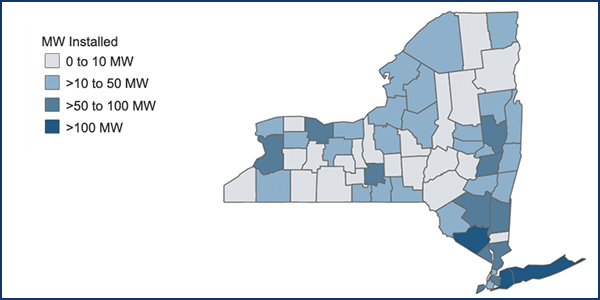The New York Public Service Commission on Thursday voted unanimously to undertake a study to identify distribution upgrades, local transmission upgrades and bulk transmission investments needed to meet the state’s clean energy goals (20-E-0197).
“In my view, this is a timely, critical and thoughtful plan to start to modernize our grid … to meet our future needs, including the need to deliver the new clean energy called for by the state’s agenda,” PSC Chair John Rhodes said.
The study was mandated by a budget amendment passed last month that created a new siting agency for renewable energy projects. The New York State Energy Research and Development Authority will collaborate with the Department of Environmental Conservation and the Department of Public Service (DPS) to develop build-ready sites for renewable energy projects. (See NY Renewable Supporters Push for New Siting Agency.)
Under the new order, transmission investments that the commission determines must be “completed expeditiously” are referred to the New York Power Authority for development and construction. Other projects are to be selected for implementation through NYISO’s public policy planning process.
“I look most importantly to the New York ISO, who has been a leader in appropriate tactical studies as it relates to the grid, especially with the reliability and resiliency aspects, and the studies that they are currently undertaking,” Commissioner Diane Burman said. “I do look to them as an important component of really critical evaluation and analysis that will be helpful.”
Commissioner John Howard said that in “the process of turning legislative goals into policy … we should be as cautious with other people’s pocketbooks as possible. This rebuilding of the grid could be enormously expensive … there’s always the temptation to gold-plate the system.”
Extended Run for NY-Sun
The commission also authorized an additional $573 million in funding to support the state’s goal to procure 6 GW in distributed solar generation by 2025 and extend the NY-Sun program to 2025, as petitioned by NYSERDA in November (19-E-0735).
DPS staff determined that the state is on track to achieve the original goal of 3 GW by 2023, with more than 2,410 MW in service in New York and more than 1,200 MW currently in development.
The NY-Sun initiative was part of the Clean Energy Fund created by the commission in 2016, which established utility collections from ratepayers to support the overall $960 million funding requirement.
Burman was the sole vote against the program extension, as she was in last month’s authorization for NYSERDA to solicit up to 2,500 MW of offshore wind energy this year. (See NYPSC Greenlights 2,500-MW Offshore Wind RFP.)
“I am really concerned about not only extending the program through 2025, which means the [ratepayer] collections continue, but also allocating additional funding — albeit it may be from reallocating uncommitted funds — and also then teeing up that we may be looking at new funding in a clean energy review,” Burman said.
Rather than indicate in the order that the PSC expects NYSERDA to report back on the impacts of the COVID-19 pandemic on the distributed solar industry, she said the commission should be asking the agency to report on that now.
“Doing this now really concerns me because, as we’ve seen, even from last session, what we saw as a need to move quickly on something didn’t necessarily mean that NYSERDA did,” Burman said.
Following the commission’s offshore authorization last month, NYSERDA said in a statement that it would not be rushing to put out a request for proposals amid the pandemic.
“My concern is that we have large-scale renewables solicitations on pause; we have the offshore wind solicitation on pause; we have a number of things that are on pause; and so the only thing not on pause is the movement of funding and the extension of programs that have ratepayer dollars attached to them,” Burman said.
Commissioner Tracey Edwards joined the call for accountability.
“I’m concerned that what we have in here that benefits the low- and moderate-income communities actually happens,” Edwards said.
She asked DPS staff to talk to NYSERDA about making the annual clean energy review into a quarterly review.
“I think it’s just critical,” she said. “Low-income communities get the brunt of environmental injustices right now, so if there are programs that are going to be put in place, we need to make sure that they are in fact working.”




